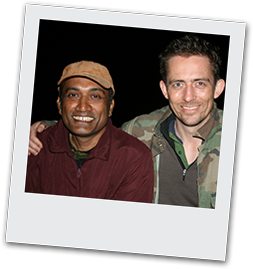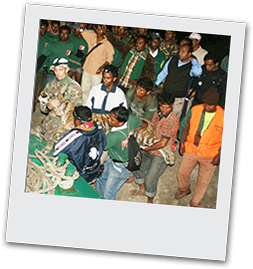OUR STORY OF REZVIN CONTINUED: her presentation of the power of TigerTeams to convince donors
….The sky is full of twinkling stars. Just before daybreak, the bright green colors of the trees come back. Birds start  singing. Thirsty deer drink water from their ponds. Somewhere in the deep dark forest the mighty royal tiger hides.
singing. Thirsty deer drink water from their ponds. Somewhere in the deep dark forest the mighty royal tiger hides.
There are many villages next to the gorgeous Sundarbans. The population exploded like fireworks. Illegal logging and poaching of deer –the favorite meal of tigers – shrank the home of these magnificent big cats. More and more often, a hungry tiger enters a village to grab a goat, cow or even a villager. Every year, many people are wounded, maimed and killed.
Some time ago Adam, one of our most dedicated team members, got the message that a tiger was just brutally killed by villagers. Adam is passionate about tigers and has worked on Tiger projects all ov er the world. Since his first steps into a tiger forest twelve years ago, he has never looked back. Hearing
er the world. Since his first steps into a tiger forest twelve years ago, he has never looked back. Hearing
about a slaughtered tiger, always breaks his heart. Adam went to the village to hear the story first hand. Adam is a strong, tall and handsome man, but a bit shy. It took some time for him to learn that you first need to listen openly, not judgmental, to gain trust of the villagers. Trust is a crucial foundation for our programs.
Rashid, who was the leader of the tiger killing, explained the sad story to Adam: “A hungry tiger entered the village. We panicked. We tried to corner it and kill it with sticks. But the fierce predator attacked us and slashed two of my friends with its giant paws. They are seriously wounded. We managed to scare the tiger into the field. We could tell the beast was very angry the way it growled at us. Then, the tiger attacked us again. Another man was bitten, dark red blood gushed from his leg. Many villagers joined us now with sticks. We closed the circle around the tiger and kept fiercely beating it with sticks while it growled, roared and hissed. I smelled the stench of his fear and urine. Finally, the big cat was killed. The crowd cheered and congratulated me with the victory”, Rashid concluded proudly.
Adam looked at the dead tiger. All there was left of the protector of the forest was a bloody mess. He almost cried, but managed to keep his pose. He knows that in this stage, it is too early to start missionary work. First you have to develop a relationship with the villagers. You don’t ask a woman to marry you on a first date. And you don’t ask villa
gers to change the way they behave in the first encounter. If you do, the shutters will go down, the atmosphere will grow ice cold, you will hit a wall. Adam experienced that the hard way.
Adam goes back to the village a couple times to talk to Rashid as he was the leader in the tiger killing. After sowing the seeds of trust, he feels the time is right to harvest.
When he enters the village, Rashid comes running towards him to welcome him. His bright eyes glitter and spark and he offers a cup of tea. Adam talks about the many threats the Sundarbans faces. He tells an old Bangladesh story about the tiger being the guardian of the Sundarbans. He says ‘We all know this forest is our life  Insurance against hurricanes and floods. Without tigers, illegal loggers will move in and destroy the forest. Development will rapidly increase. And the villagers will lose the shelter and care of the Sundarbans.
Insurance against hurricanes and floods. Without tigers, illegal loggers will move in and destroy the forest. Development will rapidly increase. And the villagers will lose the shelter and care of the Sundarbans.
Rashid reminds Adam that his grandfather was eaten by a tiger. His fellow villagers suffer from stray tigers. Their livestock is eaten, their women and children attacked. Does Adam think of that? If they want to live their lives peacefully, they simply have to kill stray tigers from time to time. It’s just the reality of present day life in the Sundarbans.
Than Adam shoots straight in the bulls eye: ‘Do you know that it is possible to save both man and tiger? Our team mastered the skills to control stray to tigers. You can be such a wizard too. The villagers will see you as a hero. That’s what happened in the fifty villages already powered with Tiger Response Teams, armed by villagers. I offer you a training program that puts you in the drivers’ seat when a famished tiger enters your territory. The law of the jungle will no longer rule. It’s no longer to kill or be killed. We teach you and your team members how to scare the tiger back in the forest without being attacked. When the tiger is too far in the village, we teach you how to fix its location without hurting anybody. And you will master the skills of crowd control. You will know the tricks how to calm the roaring and panicking villagers. We will give you a phone to contact the Forest Department and our emergency team. They will come with their guns and tranquillizers, put the tiger to sleep and return it to the forest. Everybody wins. Why don’t I give you and a few volunteers a first training session next week? No strings attached!
Rashid feels challenged and curious. He says yes. The next weeks, the training is delivered. Adam welcomes the new Village Tiger Response Team after the members pass all tests. Since then, two stray tigers were safely returned from this village to the forest. The villagers now cheer and congratulate Rashid for saving the tiger instead of bludgeoning it to death.
Since WildTeam started the tiger teams, we saved many, many tigers. And the word spreads fast. WildTeam now get requests from new villages to start our training programs. There is a waiting list for volunteers in the villages with Tiger Response Teams.
And there is more. Adam found out that Rashid used to be a poacher, his nick name in the village was ‘deer hunter’. Being a proud member of the tiger team made him stop. How can you save tigers and steal their major pray at the same time? That makes no sense! Some of our tiger teams even set up junior teams by own initiative to mobilize the younger generation. The volunteers tell a story that sticks: ‘The Sundarbans protect us, the tiger protects the Sundarbans, by saving the tiger, we protect ourselves’.
We invite you to board our ship and save the jewel of our country, the Sundarbans, by saving its royal protector and our national symbol: the Bengal tiger. Do you have the courage to join us and sponsor a team? If so, we will inform you about the team’s progress and the number of tigers saved from a brutal and unnecessary dead by your help. We challenge you to be a hero too and take this step.
Thank you for your attention, I feel privileged for the opportunity to tell our story.
Strategic elements of the story

Target audience: potential donors attending a Rotary Club meeting
Key point: We develop and implement great effective programs, rooted in culture, coming straight from the heart. If you donate, you become one of us.
Conflict: we have the solution but not the capacity to implement it
Hero: Rezvin
Adversary: The fear of tigers and the number of villagers to convince of WildTeam’s approach

